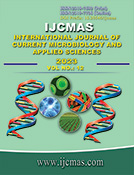


 National Academy of Agricultural Sciences (NAAS)
National Academy of Agricultural Sciences (NAAS)

|
PRINT ISSN : 2319-7692
Online ISSN : 2319-7706 Issues : 12 per year Publisher : Excellent Publishers Email : editorijcmas@gmail.com / submit@ijcmas.com Editor-in-chief: Dr.M.Prakash Index Copernicus ICV 2018: 95.39 NAAS RATING 2020: 5.38 |
Ber (Ziziphus sp.) is a nutritionally rich fruit especially with respect to minerals and vitamins viz., phosphorous, calcium, iron and vitamins A, B and C. However, due to its small size and stone inside, slightly bitter or pungent taste, the fruit is not popularly consumed and utilized. ‘Labdae’ is a local name for ber-preserve made from local variety or underutilized ber fruit in Vindhya plateau of Madhya Pradesh. The product utilizes whole ber fruit, slightly dried and fully ripe, which is cooked by soaking in sugar solution. In the present investigation, the fresh, healthy ber fruits from the local seller were purchased. The ber fruits were washed and dried using three different methods viz., sun drying, microwave drying and drying at room temperature. The dried ber fruits were further used for the preparation of ber-preserve i.e., ‘Labdae’, as is commonly known in local language. The recipe for the preparation of Labdae was standardized in the laboratory and slight modifications were done in the ‘basic’ recipe as per the experiment. The recipe was standardized for both the slow and quick method of preserve preparation. The standardized products from each category were evaluated for its sensory acceptability and chemical properties. The conventional ber-preserve available in the market was kept as ‘control’ for evaluation purpose. The final prepared product contained 21.23 – 22.89 per cent moisture, with TSS between 64.82 – 66.92OBrix and 1.13- - 1.80 per cent acidity (as citric acid). The organoleptic scores of the laboratory prepared ber-preserve as compared to locally available product revealed higher acceptability scores for colour (6.92), taste (6.92), flavour (7.04), mouthfeel (7.21) and overall acceptability (7.02) on the basis of 9 point hedonic scale. Hence as per the study, ber-preserve is a good option for utilizing and preserving the nutritious properties of an under-utilized. As the drying method and cooking process also improved its acceptability ‘Labdae’ (the traditional ber-preserve) could make a move in the modern kitchens as a nutritious, fruit-based sweet-meat option.
 |
 |
 |
 |
 |